Toho Studios and the dynamic duo of director Ishiro Honda and special effects wizard Eiji Tsubaraya are best known in the U.S. for their kaiju films starring Godzilla, Rodan, Mothra, King Ghidorah, and other giant inhabitants of Monster Island. But their kaiju films were far from their only excursions into the science fiction and horror realms. At least three such Toho flicks are notable for featuring amorphous aliens, shapeless specters, random radioactive rascals, or fiends without form (there – I think I’ve exhausted my alliterative abilities, at least for the moment).
Although the best known monstrous mass of moldy goo from 1958 is undoubtedly The Blob, the first film to feature Steve McQueen in a starring role (and also memorable for its tongue-in-cheek hit theme song), Toho actually beat Paramount Pictures to the punch with their not-too-dissimilar horror flick, The H-Man (the former was released in September, 1958, whereas the latter was released in Japan in June, 1958, first appearing in the U.S. in May of the following year). The original title of this sprightly horror film was Beauty and Liquid Men, which suffers when translated into English, as do many Japanese film titles.
As with so many Japanese films of the period, the monsters are created by nuclear radiation out at sea (this is also the scientific explanation behind the mutagenic mushrooms found on the deserted island in Matango). Special effects technician Eiji Tsubaraya, the man behind the effects in all of the Godzilla pictures from the original Godzilla, King of the Monsters to Godzilla’s Revenge, designed the “liquid men” as blue effluence that could move of its own volition and take on roughly human shape.
With much of the film’s action set in or near a nightclub, Masaru Sato composed a jazzy score that adds much liveliness to the film. The nightclub acts give the film a kitschy, vintage charm. The monsters themselves aren’t very scary, until you see one dissolve a beautiful singer. The film’s climax, set in the sewers beneath Tokyo, reminds me of the subterranean climax of Them! (where the giant ants are cornered by the army in the storm sewers beneath Los Angeles. It also adds a good bit of genuine horror to this science fiction pic.
On account of the gangsters and their molls, the nightclub singers, and that suspenseful climax, I give The H-Man three stars out of five.
My favorite of this amorphous “trilogy” is definitely Matango (alternatively titled Attack of the Mushroom People or Matango, Fungus of Terror — the latter one of the all-time great monster film titles). In part, this is because I watched it at least half a dozen times as a kid on late-night or Saturday afternoon TV, so it made a big impression on me. Also, it is an unusual film for Toho and director Ishiro Honda in that it mainly focuses on psychological horror, rather than physical monsters. This is mainly due to its origins in the William Hope Hodgson story, “The Voice in the Night,” a 1907 tale of psychological horror (which I have not yet read, but which is on my list).
A group of young Japanese men and women on a pleasure yacht are forced to beach their craft on a seemingly deserted island after a fierce storm at sea damages their boat. Much of the island is covered by a rapidly growing fungus, as is another beached yacht, this one abandoned, which they come across. They quickly run out of canned foods and are forced to forage on the island. The yacht’s captain warns them not to eat the mushrooms, as they may be poisonous. They subsist for a while on bird’s eggs (although most birds avoid the island), potatoes, and seaweed, but one of their number succumbs to the call of the mushrooms and eats some. Their influence drives him mad, and he attacks his fellow castaways. One by one, the members of the yachting party eat the mushrooms, and they begin to see shambling, walking mushrooms, some of which appear vaguely human…
I won’t spoil the ending for those of you who haven’t yet seen it, but it’s a doozy. I give Matango four out of five stars for its atmospheric horror, unusual for a Toho film.
Before the script for Giant Space Monster Dogora (retitled Dagora, the Space Monster for American television) was written, I picture Ishiro Honda having the following conversation with monster master Eiji Tusburaya:
“Okay, we’ve done a combination Tyrannosaurus Rex and Stegosaurus (Godzilla, King of the Monsters),” says Honda.
“Check,” says Tusburaya.
“We’ve done a pair of love-sick pterodactyls (Rodan).”
“Check.”
“We’ve done a giant moth (Mothra).”
“Check.”
“We’ve done a giant flying squirrel (no, not Rocky of Rocky and Bullwinkle fame, but Varan the Unbelievable).”
“Check.”
“We’ve done a three-headed dragon that spits lightning bolts (Ghidorah, the Three-Headed Monster).”
“Check.”
“So what kind of monster haven’t we done?”
“How about a giant space jellyfish that eats coal and dies when exposed to plentiful doses of wasp venom?”
“Fabulous! Get me a script writer!”
Yes, the creature does end up being vulnerable to wasps’ venom, which turns its jelly-like substance crystalline. One of the funniest scenes in the movie (perhaps inadvertent; I couldn’t tell) comes when a trio of hard-luck diamond thieves (Dagora eats carbon; that’s the connection with the jewel thieves) are suddenly crushed by a falling chunk of the crystallized monster while hiding behind a big rock on a beach. Violent slapstick worthy of the Keystone Cops.
This is one of the only Toho science fiction or kaiju films in which the giant monster is not played by a man in a rubber suit. Also, Dogora/Dagora was one of the only Toho giant creatures to not appear in the all-star kaiju cast of Destroy All Monsters in 1968 (c’mon, even Varan the giant flying squirrel puts in a brief appearance in that film).
Despite the beauty of some of the scenes of Dagora in the night sky over Japan, I can only give Dagora, the Space Monster two point five stars out of five, due to the incredibly convoluted nature of its story, involving diamond thieves, coal deposits, wasps, etc. etc. etc. A little too baroque for its own good, I’d say. If only more of the film could have had that fabulous sense of wonder inspired by those few scenes of the creature floating over Tokyo in the night sky…

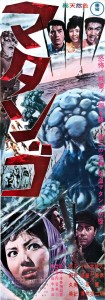
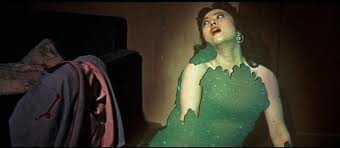
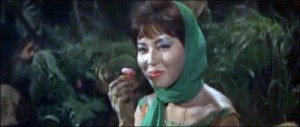
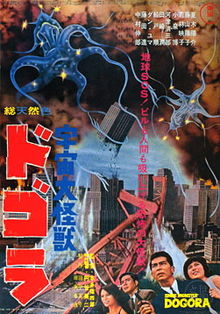
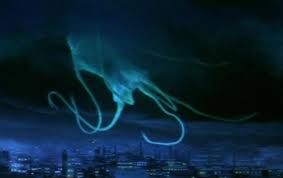




I’ve been trying to remember the title of “Matango” for *years* now so that I could track it down and watch it again. It was “Attack of the Mushroom People” when I saw it as a kid on a Saturday afternoon, like you did. And it scared me far more than any of the Godzilla/Rodan/Mothra movies my mother always worried about.
So glad I could be of assistance, Wesley! Glad you enjoyed the article.